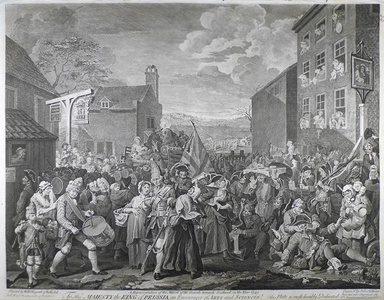| Method | Copper engraving and etching |
| Artist | Luke Sullivan after William Hogarth |
| Published | Painted, by Willm. Hogarth & Publish'd Decbr. 31st. 1750, According to Act of Parliament. Engrav'd by Luke Sullivan. Retouched and Improved by Wm. Hogarth, republish'd June 12th 1761. [J & J Boydell c.1802] |
| Dimensions | Image 414 x 545 mm, Plate 432 x 553 mm, Sheet 465 x 645 mm |
| Notes |
A lively scene of British troops at the Tottenham Court Turnpike, at the intersection of the Euston and Hampstead roads, in September 1745. The troops have been newly recalled from the Low Countries to protect London from the invasion of Bonnie Prince Charlie, and are here supposed to be marching north of the city to Finchley. Instead, they are depicted in a scene of the most raucous and utmost disorder, in contrast to ranks of regulars that appear in the background, marching towards the village of Hampstead on the rise. At the centre of the scene, a soldier is caught between two women who both vie for his attention. One, an older woman, seems to represent both the Catholic Faith, a crucifix on her shawl, and the Jacobite cause, carrying a bag of sympathiser pamphlets. The other, a heavily pregnant young ballad-singer, evidently acts as a contrast, carrying a basket that includes a ballad 'God save our Noble King.' To the left, a dishevelled drummer, who should be busy drumming the marching order of his unit, is hassled by his wife and a squalling child. The rest of the scene is a riot of confusion and vice. Behind the central figures, a soldier gropes a milkmaid while his fellow pours the contents of her milk-churn into his hat. Another soldier steals a pie from a gormless baker, who carries his products on a tray on his head. Two other's drain ale from an uncorked keg, while a pair of royal messengers engage in a clumsy drinking contest, knocking each other into a puddle. On one side of the road, soldiers bid farewell to scores of prostitutes, who hang from the windows of the 'King's Head' pub, while on the other side of the road, a man urinates painfully against the wall of another pub, the 'Adam and Eve,' reading a timely advertisement for Dr Rock's quack venereal disease treatments. The plate is inscribed below the image with a dedication: 'To His Maiesty the King of Prussia, an Encourager of Arts and Sciences! This Plate is most humbly Dedicated.' The reason behind Hogarth's decision to dedicate his plate to Frederick II has been the cause for some debate, though it is likely to have at least been intended in part to draw attention to George II's notorious lack of interest in the Arts. Luke Sullivan (1705 - 1771) was a London-based Irish engraver and miniature painter. He was supported in his early career by the Duke of Beaufort, his father having worked for the Duke as a groom. His best known works were completed as an assistant to William Hogarth, though Hogarth was reputed to have had difficulty working with Sullivan, owing to the latter's erratic behaviour and frequent absences. Later in his career he worked on engravings of various British views, including that of Stonehenge for Grose's 'Antiquities of England and Wales,' as well as having some success as a miniaturist with the Society of Artists. William Hogarth (1697 - 1764) was born in London, the son of an unsuccessful schoolmaster and writer from Westmoreland. After apprenticeship to a goldsmith, he began to produce his own engraved designs in about 1710. He later took up oil painting, starting with small portrait groups called conversation pieces. He went on to create a series of paintings satirising contemporary customs, but based on earlier Italian prints, of which the first was The Harlot's Progress (1731), and perhaps the most famous The Rake's Progress. His engravings were so plagiarised that he lobbied for the Copyright Act of 1735, commonly referred to as 'Hogarth's Act,' as a protection for writers and artists. During the 1730s Hogarth also developed into an original painter of life-sized portraits, and created the first of several history paintings in the grand manner. Paulson 184 viii/ix, BM Satires 2639 Condition: Excellent impression, tear to left hand margin, some slight surface dirt to sheet . Paper watermarked 'S.Lay 1802' |
| Framing | unmounted |
| Price | £475.00 |
| Stock ID | 38101 |

